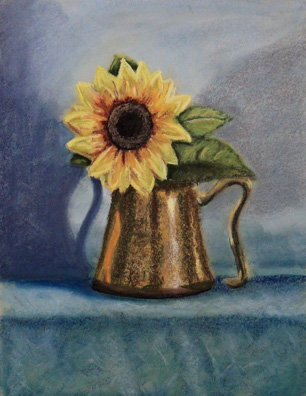Sunflower in a Brass Cup
(Or Man's Inhumanity to Man)

Again a pastel exercise with drawing shiny stuff. This is (obviously) a sunflower in a (hopefully obviously) brass cup. There's a few leaves, too.
The way to draw shiny stuff can be confounding when first attempted, but once you get the principles down it's actually kind of fun. The trick is to look at the object less for what it is than what it looks like. That is, don't see it as a brass cup or a glass vase. Instead look at it as a bunch of shapes of different colors fitting together in certain patterns. Get the overall outline in its correct proportion, and then fill in the patterns, and hey, presto!, you get a shiny cup or a glass vase.
Brass, for those who may be interested, is an alloy of (mostly) copper and (not as much) zinc. The proportions vary depending on the type of brass you want. Although now looked on as a cheap and rather kitschy metal, if you have about 65% copper and 35% zinc, it looks enough like gold to fool the uninitiated. Brass was actually used in some Roman coins, but this wasn't deliberate deception since the average Romans could tell brass from gold. For one thing brass quickly tarnishes on contact with the air and starts to look like, well, like tarnished brass. Bronze, by the way, is copper with tin, although there are various other "bronzes" where you add other stuff. Some bronzes can give you a simulated gold look.
The most famous painter of sunflowers was Vincent Van Gogh. He created a lot of paintings with sunflowers, including about seven versions of the famous "Sunflowers" everyone knows about - although some people think at least one of those seven might be a forgery. Of course, a lot of people like to think of themselves as "fakebusters" who by style and "connoisseurship" can immediately spot a fake. Connoisseurship arguments, though, often degenerate into "I-am-an-expert-and-and-that-settles-it" spittle-flinging diatribes. Such assertions rarely convince someone who's paid 100 or so million for a painting.
Lest art curators take umbrage at these comments, it is quite true that experienced curators can often identify an artist by the style alone. Recently a museum curator was shown a painting that was in a little-used hallway of a building owned by one of the city's more venerable organizations. The painting had been hanging there as long as anyone could remember. No one knew who the artist was as the painting had no signature. But the curator pointed out that the way the trees were rendered looked like those in a painting in her museum by a American artist from the early 1800's. After checking various records, it turned out that the organization had indeed purchased the painting from the artist in the 1830's.
American and British, by the way, will get into spittle flinging diatribes about how to pronounced Vincent's name. The Americans say VIN-cent van GOH while their English cousins render it VIN-cent van GOFF. Neither is correct. The true Dutch pronunciation is more like FIN-cent fen HOHKH.
Enokh said.